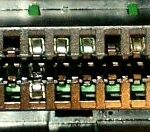The P0325 error code, as defined by the OBDII (On-Board Diagnostics II) and EOBD (European On-Board Diagnostics) standards, indicates a malfunction within the Knock Sensor 1 circuit. This diagnostic trouble code is common across a wide range of vehicles equipped with these systems and signals a potential issue that can affect engine performance and longevity. As an expert at autelfrance.com, we understand the importance of accurately diagnosing and resolving such issues. This article will delve into the specifics of the P0325 code, providing you with a comprehensive understanding of its meaning, symptoms, causes, and effective solutions.
Understanding the P0325 Code
The knock sensor plays a crucial role in modern engine management. Its primary function is to detect engine knocking or detonation. Knocking occurs when the air-fuel mixture in the cylinders ignites in an uncontrolled and uneven manner, rather than a smooth, controlled burn. This abnormal combustion can lead to reduced engine power and, if left unaddressed, potentially serious engine damage.
The engine control module (ECM) uses signals from the knock sensor to adjust ignition timing, and sometimes fuel mixture, to prevent knocking. The P0325 code is triggered when the ECM detects an abnormality in the electrical circuit of knock sensor 1. This doesn’t necessarily mean the sensor itself is faulty; the issue could lie within the wiring, connections, or even the ECM itself. It’s important to address a P0325 error promptly to ensure optimal engine performance and prevent potential damage.
Symptoms of a P0325 Error
When your vehicle logs a P0325 code, you may observe several symptoms, including:
- Check Engine Light Illumination: This is the most common and immediate symptom. The malfunction indicator lamp on your dashboard will light up to alert you to a detected issue.
- Reduced Engine Power: Engine knock is inefficient combustion. The ECM may also retard ignition timing as a precautionary measure when a knock sensor issue is suspected, further reducing power output.
- Engine Hesitation: You might notice hesitation or stumbling during acceleration as the engine struggles to perform optimally.
- Engine Detonation or Pinging Noises: In some cases, you might actually hear audible pinging or knocking sounds coming from the engine, especially under acceleration or load.
- Decreased Fuel Efficiency: Inefficient combustion and the ECM’s attempts to compensate can lead to higher fuel consumption.
A typical knock sensor, often bolted to the engine block. Diagnosing P0325 errors may involve checking this sensor and its connections.
Common Causes of P0325
Several factors can trigger a P0325 code. Identifying the root cause is crucial for effective repair:
- Faulty Knock Sensor: The sensor itself may have failed due to age, physical damage, or internal electrical issues.
- Wiring Problems: Damage to the wiring harness leading to the knock sensor, such as shorts, open circuits, corrosion, or fraying, can disrupt the signal.
- Loose or Corroded Connectors: Poor connections at the knock sensor or ECM can cause intermittent or complete signal loss.
- PCM/ECM Failure: Although less common, a fault within the Powertrain Control Module (PCM) or Engine Control Module (ECM) can also lead to a P0325 code.
Diagnosing and Resolving P0325 – Step-by-Step
Diagnosing a P0325 code requires a systematic approach. Here are steps to guide you through the process:
- Initial Scan: Use an OBDII/EOBD scanner to confirm the presence of the P0325 code and check for any other related codes. Autel offers a range of professional-grade scan tools perfect for this task.
- Visual Inspection: Carefully inspect the knock sensor, its wiring, and connectors for any signs of damage, corrosion, or loose connections.
- Resistance Test: Use a multimeter to measure the resistance of the knock sensor. Compare the reading to the manufacturer’s specifications. An out-of-range reading suggests a faulty sensor.
- Wiring Circuit Test: Check for continuity and shorts in the wiring between the knock sensor and the ECM. Repair any wiring faults identified.
- Connector Check: Ensure the connectors at both the sensor and ECM are clean, secure, and making good contact.
- PCM/ECM Check (Advanced): If all other components test within specifications, the PCM/ECM may be the issue. This usually requires advanced diagnostic equipment and expertise.
Possible Solutions:
- Knock Sensor Replacement: If the sensor is faulty, replacing it with a new, OEM-quality sensor is the most likely solution.
- Wiring Repair: Repair or replace any damaged wiring or connectors in the knock sensor circuit.
- ECM/PCM Repair or Replacement: In rare cases, ECM/PCM replacement or reprogramming might be necessary.
Utilizing the freeze frame data captured by your Autel scan tool when the P0325 code was set can provide valuable insight into the conditions present at the time of the fault. This information can further streamline the diagnostic process.
Conclusion
The EOBD/OBDII error code P0325 indicates a malfunction in the knock sensor 1 circuit, which can lead to reduced engine performance and potential damage if ignored. By understanding the symptoms, causes, and diagnostic steps outlined in this guide, you can effectively troubleshoot and resolve this issue. Remember to use professional-grade tools like those from Autel for accurate diagnostics and efficient repairs. Addressing a P0325 code promptly will ensure your vehicle operates optimally and reliably.

